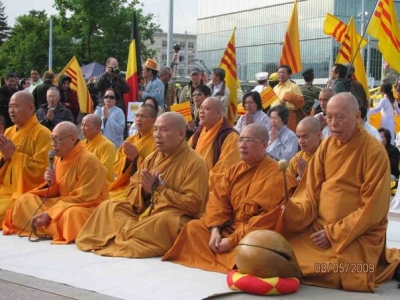In theory there are three main religions in Vietnam: Taoism, Confucianism and Buddhism; but in fact there is “tripple religion”, which is an amalgamation of these three doctrines, each of which represents a particular aspect of the whole. And now Buddhism still is main religion in Vietnam.

Buddhism spread first from China to Vietnam's Red River Delta region in approximately the second century A.D., and then from India to the southern Mekong Delta area at some time between the third and the sixth centuries. The Chinese version, Mahayana Buddhism, became the faith of most Vietnamese, whereas the Indian version, Theravada (or Hinayana) Buddhism, was confined mostly to the southern delta region. The doctrinal distinction between the two consists of their differing views of Gautama Buddha: the Mahayana school teaches that Gautama was only one of many "enlightened ones" manifesting the fundamental divine power of the universe; the Theravada school teaches that Gautama was the one-and-only enlightened one and the great teacher, but that he was not divine. The Mahayana sect holds further that laypersons can attain nirvana, whereas the Theravada school believes that only ordained monks and nuns can do so.
At the 13 century, during the Tran dynasty (1225-1400), the first 3 Kings Trần Thái Tôn, Trần Thánh Tông, Trần Nhân Tông and many high-ranking mandarins and royal members were Zen Buddhists. Among them King Trần Nhân Tông was the most prominent, being the founder of Trúc Lâm Yên Tử Zen School after his retirement from the throne in 1299. The essence of Truc Lam Yen Tu Zen school is to “live the dharma” and Trần Nhân Tông’s life is the illustrated example. Trần Nhân Tông’s Truc Lam Yen Tu Zen School marked the beginning and foundation of Vietnamese Buddhism, which is exemplified by the tenet, “Dharma applied to worldly life,” all of the characteristics of which are outlined in the verse Cư Trần Lạc Đạo. In this interpretation of Buddhism, practicing Buddhism is not limited to ritual activities, worship, and meditation, but right within daily activities. There is no need to search for enlightenment and peace anywhere outside of self and of the environment one lives in.
Vietnamese Buddhism continues to hold this supremacy in our own time. It is therefore easy to understand how great an influence the Buddha has had on the Vietnamese mind, and the generous contribution it has made to the moral and spiritual training of a people whose gentleness and simple outlook on life predisposed them to accept the «Religion of Compassion.»






































































































